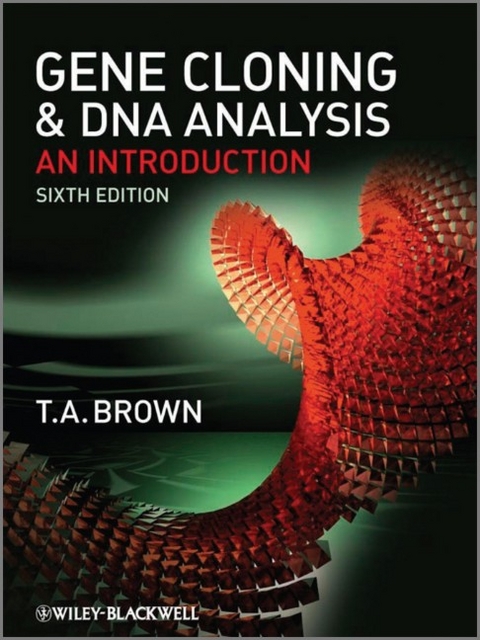
Gene Cloning and DNA Analysis
Wiley-Blackwell (an imprint of John Wiley & Sons Ltd) (Verlag)
978-1-4443-3407-4 (ISBN)
- Titel ist leider vergriffen;
keine Neuauflage - Artikel merken
All libraries in universities where medical, life and biological sciences are studied and taught should have copies available on their shelves. "...the book content is elegantly illustrated and well organized in clear-cut chapters and subsections...there is a Further Reading section after each chapter that contains several key references...What is extremely useful, almost every reference is furnished with the short but distinct author's remark." -Journal of Heredity, 2007 (on the previous edition)
Preface to the Sixth Edition. Part 1: The Basic Principles of Gene Cloning and DNA Analysis. 1 Why Gene Cloning and DNA Analysis are Important. 1.1 The early development of genetics. 1.2 The advent of gene cloning and the polymerase chain reaction. 1.3 What is gene cloning? 1.4 What is PCR? 1.5 Why gene cloning and PCR are so important. 1.6 How to find your way through this book. 2 Vectors for Gene Cloning: Plasmids and Bacteriophages. 2.1 Plasmids. 2.2 Bacteriophages. 3 Purification of DNA from Living Cells. 3.1 Preparation of total cell DNA. 3.2 Preparation of plasmid DNA. 3.3 Preparation of bacteriophage DNA. 4 Manipulation of Purified DNA. 4.1 The range of DNA manipulative enzymes. 4.2 Enzymes for cutting DNA - restriction endonucleases. 4.3 Ligation - joining DNA molecules together. 5 Introduction of DNA into Living Cells. 5.1 Transformation - the uptake of DNA by bacterial cells. 5.2 Identification of recombinants. 5.3 Introduction of phage DNA into bacterial cells. 5.4 Identification of recombinant phages. 5.5 Introduction of DNA into non-bacterial cells. 6 Cloning Vectors for E. coli. 6.1 Cloning vectors based on E. coli plasmids. 6.2 Cloning vectors based on M13 bacteriophage. 6.3 Cloning vectors based on l bacteriophage. 6.4 lambda and other high capacity vectors enable genomic libraries to be constructed. 6.5 Vectors for other bacteria. 7 Cloning Vectors for Eukaryotes. 7.1 Vectors for yeast and other fungi. 7.2 Cloning vectors for higher plants. 7.3 Cloning vectors for animals. 8 How to Obtain a Clone of a Specific Gene. 8.1 The problem of selection. 8.2 Direct selection. 8.3 Identification of a clone from a gene library. 8.4 Methods for clone identification. 9 The Polymerase Chain Reaction. 9.1 The polymerase chain reaction in outline. 9.2 PCR in more detail. 9.3 After the PCR: studying PCR products. 9.4 Real time PCR enables the amount of starting material to be quantified. Part 2: The Applications of Gene Cloning and DNA Analysis in Research. 10 Sequencing Genes and Genomes. 10.1 The methodology for DNA sequencing. 10.2 How to sequence a genome. 11 Studying Gene Expression and Function. 11.1 Studying the RNA transcript of a gene. 11.2 Studying the regulation of gene expression. 11.3 Identifying and studying the translation product of a cloned gene. 12 Studying Genomes. 12.1 Genome annotation. 12.2 Studies of the transcriptome and proteome. Part 3: The Applications of Gene Cloning and DNA Analysis in Biotechnology. 13 Production of Protein from Cloned Genes. 13.1 Special vectors for expression of foreign genes in E. coli. 13.2 General problems with the production of recombinant protein in E. coli. 13.3 Production of recombinant protein by eukaryotic cells. 14 Gene Cloning and DNA Analysis in Medicine. 14.1 Production of recombinant pharmaceuticals. 14.2 Identification of genes responsible for human diseases. 14.3 Gene therapy. 15 Gene Cloning and DNA Analysis in Agriculture. 15.1 The gene addition approach to plant genetic engineering. 15.2 Gene subtraction. 15.3 Problems with genetically modified plants. 16 Gene Cloning and DNA Analysis in Forensic Science and Archaeology. 16.1 DNA analysis in the identification of crime suspects. 16.2 Studying kinship by DNA profiling. 16.3 Sex identification by DNA analysis. 16.4 Archaeogenetics - using DNA to study human prehistory. Glossary. Index.
| Zusatzinfo | ill |
|---|---|
| Verlagsort | Chicester |
| Sprache | englisch |
| Maße | 195 x 249 mm |
| Gewicht | 954 g |
| Einbandart | gebunden |
| Themenwelt | Informatik ► Weitere Themen ► Bioinformatik |
| Naturwissenschaften ► Biologie ► Genetik / Molekularbiologie | |
| Naturwissenschaften ► Biologie ► Mikrobiologie / Immunologie | |
| ISBN-10 | 1-4443-3407-7 / 1444334077 |
| ISBN-13 | 978-1-4443-3407-4 / 9781444334074 |
| Zustand | Neuware |
| Haben Sie eine Frage zum Produkt? |
aus dem Bereich


